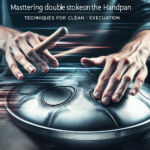For handpan enthusiasts who have moved beyond the foundational aspects of playing their instrument, the concept of modal interchange offers a rich and deeply expressive palette of sounds and moods. Modal interchange, also known as mode mixture, involves borrowing chords from parallel modes to add chromaticism and interest to music. While this technique is commonly explored within Western tonal music, it provides even more fascinating possibilities when applied to the unique sonic landscape of the handpan.
Understanding Modal Interchange
Modal interchange refers to the practice of using chords from parallel modes within the same musical composition. Parallel modes share the same tonic note but have different arrangements of intervals between notes. For example, in the key of C, parallel modes include C major (Ionian), C minor (Aeolian), C Dorian, C Phrygian, and so on.
By borrowing chords from these different modes, musicians can introduce unexpected harmonic twists and color into their music. This technique can significantly enhance the expressiveness and emotional depth of a handpan piece, which is particularly relevant given the handpan’s capacity for nuanced, resonant sound.
Applying Modal Interchange to the Handpan
The handpan, with its otherworldly tones and scales, naturally lends itself to modal experimentation. Most handpans are tuned to specific scales, often inspired by or directly derived from traditional musical modes. Integrating modal interchange requires a thoughtful understanding of the instrument’s layout and the intervals each note represents.
Here are a few steps to effectively apply modal interchange on a handpan:
1. Know Your Scale
Different handpans come with varied scale tunings. Some are tuned to a major scale while others to a minor scale, or even less common modes such as Dorian or Lydian. Understand the scale you’re working with and the notes it contains. This foundational knowledge allows you to recognize which notes belong to the primary mode of your piece and which can be borrowed from parallel modes.
2. Identify Parallel Modes
Determine which parallel modes share your tonic note. If you’re working with a D minor handpan, for example, your parallel modes include D major (Ionian), D Dorian, D Phrygian, D Lydian, D Mixolydian, and D Locrian. Each of these modes offers a different color and emotional quality.
3. Borrowing Chords
Experiment with borrowing chords from these parallel modes. Start by introducing a single chord and observing how it changes the mood of your piece. For instance, if you’re in a D minor tonality, try borrowing the D major chord (D Ionian) to introduce a brighter, more hopeful sound.
Similarly, borrowing chords like the bVII from the Mixolydian mode or the bVI from the Aeolian mode can add depth and complexity. Always be mindful of how these borrowed chords resolve to maintain a coherent harmonic progression.
4. Practice and Play
As with any advanced technique, practice is essential. Play through standard progressions and gradually incorporate borrowed chords. Over time, your familiarity with how these chords interact will grow, allowing you to seamlessly integrate modal interchange into your performances.
Creative Examples of Modal Interchange
Let’s explore several examples to illustrate the power of modal interchange on the handpan:
Aeolian to Ionian
Suppose you are playing in A minor (Aeolian). Typically, the chord progression might include Am, Dm, and Em. To introduce a different feel, you could borrow the C major chord from A Ionian. This progression could become Am, Dm, C, lending an unexpected brightness to a typically minor tonality.
Dorian Borrowing from Phrygian
If your handpan is tuned to D Dorian (minor scale with a raised 6th), you might include chords such as Dm, G, and Am. By borrowing the Bb major chord from D Phrygian, you add a somber and grounded quality to the music. A progression like Dm, Bb, G can add a compelling tension and release.
Mixolydian Color
Playing in G Mixolydian (major scale with a lowered 7th), you might typically use chords such as G, F, and C. If you borrow the Bm chord from G Ionian, it introduces a surprise spark to the piece. A progression such as G, Bm, F, C plays with listener expectations and enriches the harmonic texture.
Challenges and Considerations
While modal interchange opens up new creative possibilities, it also comes with its own set of challenges:
1. Tuning Limitations
Handpans are finely crafted instruments with fixed tunings, which means not every note may be available. This can make it challenging to execute certain modal interchanges precisely as you might on a more flexible instrument like the piano. Work within the bounds of your instrument and explore creative ways to suggest borrowed harmonic flavors.
2. Harmonic Cohesion
It’s easy to get carried away with the novelty of modal interchange, but it’s essential to ensure that the borrowed chords serve the overall musical narrative. Randomly inserting chords without regard to their resolution or the overall progression can lead to a disjointed and confusing piece.
3. Technical Proficiency
Executing modal interchange smoothly requires a certain level of technical proficiency. Musicians must be adept at navigating their handpan scales, executing smooth chord transitions, and voicing borrowed chords in a way that integrates seamlessly with the rest of the piece.
Techniques for Mastering Modal Interchange
Here are some techniques to master modal interchange on your handpan:
1. Ear Training
Develop your ear to recognize the distinct sounds of different modes and the borrowed chords. Spend time listening to and identifying modal music in different genres. This auditory familiarity is critical for effective modal interchange.
2. Slow Practice
Practice slow and deliberate transitions between borrowed chords and the primary mode chords. Pay attention to the emotional impact and harmonic coherence of each transition. Slow practice helps internalize these movements, allowing for more fluid playing in performance settings.
3. Use of Drone Notes
Maintaining a drone note (the tonic) can help ground your music while you experiment with borrowing chords from parallel modes. This technique ensures that despite the harmonic shifts, the piece remains anchored to its root, providing a sense of stability.
4. Recording and Analyzing
Record your practice sessions and performances. Analyze these recordings to understand how effective your modal interchange techniques are. Note which progressions work well and which might need rethinking or refinement.
Conclusion
Modal interchange is a powerful technique that can elevate your handpan music to new levels of emotional depth and complexity. Though it requires a solid understanding of musical modes and a careful, practiced approach, the rewards are significant. By borrowing chords from parallel modes, you introduce new colors, moods, and harmonic richness to your pieces, enhancing the inherent beauty of the handpan’s sound.
As with any advanced technique, patience and persistent practice are key. Experiment with different modes, listen critically to your progressions, and always keep the emotional narrative of your music in focus. Over time, you’ll find that modal interchange becomes a natural and expressive part of your handpan playing vocabulary.
FAQs
1. What is modal interchange?
Modal interchange is the practice of borrowing chords from parallel modes (modes that share the same tonic but have different interval arrangements) within the same musical piece. This technique adds chromaticism and depth to the music.
2. Why is modal interchange beneficial for handpan music?
Modal interchange enhances the expressiveness and emotional depth of handpan music by introducing unexpected harmonic twists. Given the handpan’s resonant sound, this technique can bring new color and interest to your compositions.
3. How do I know which chords to borrow from parallel modes?
Start by understanding the scale your handpan is tuned to and identifying the notes in parallel modes that share the same tonic. Experiment with integrating individual chords from these parallel modes and observe how they affect the overall mood and progression of your piece.
4. Are there limitations to using modal interchange on the handpan?
Yes, the fixed tuning of handpans can limit the ability to execute certain modal interchanges. Additionally, musicians must ensure harmonic cohesion and be capable of integrating borrowed chords smoothly to avoid a disjointed sound.
5. How can I practice modal interchange effectively?
Focus on ear training to recognize different modes, practice transitions slowly, use drone notes to maintain tonality, and record and analyze your sessions. These techniques will help you master the integration of modal interchange into your handpan performances.





